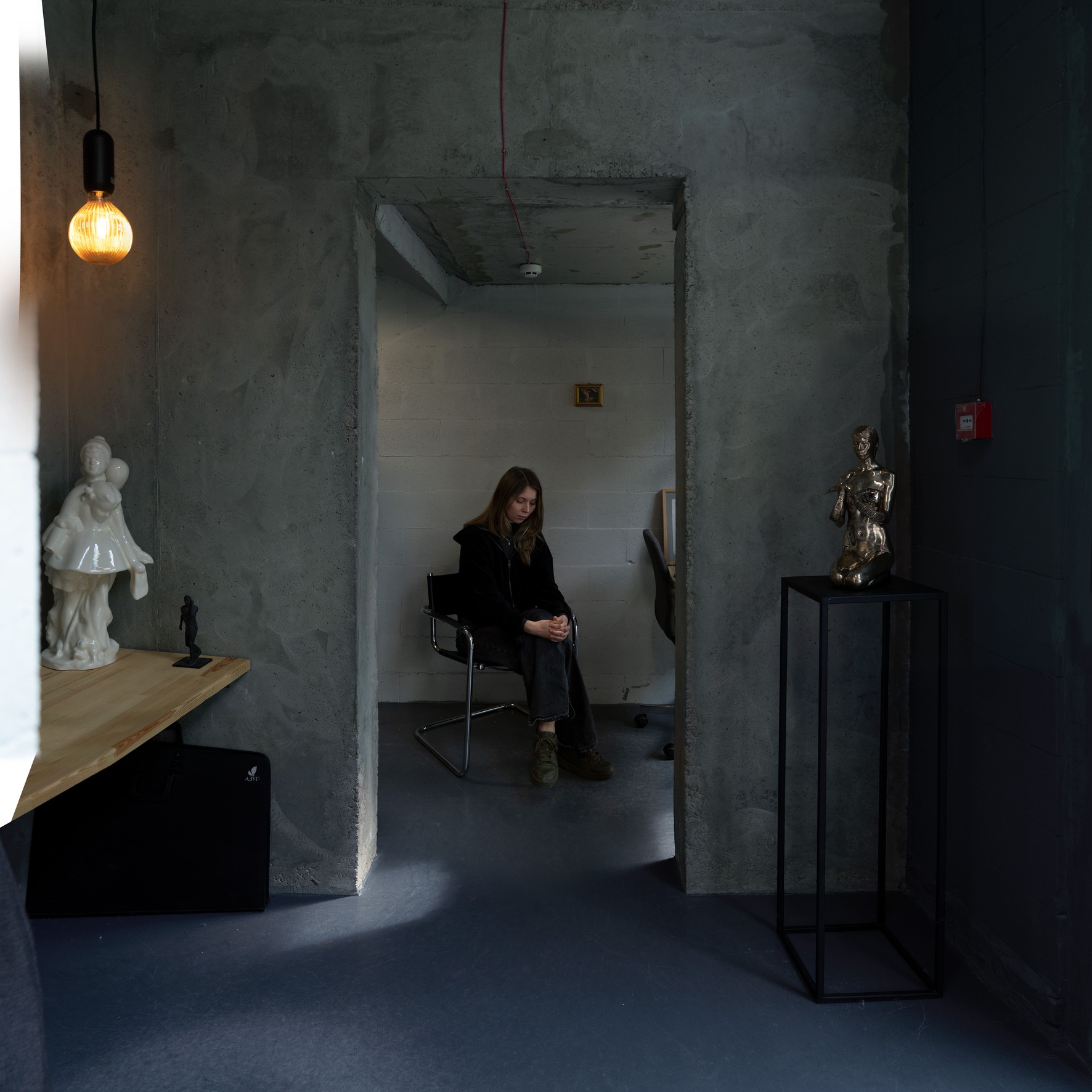Юлія Беляєва
Julia Beliaeva
«Мистецькі проєкти врятували мене, щоб не зійти з розуму. Життя рухається від виставки до виставки, і цей ритм став опорою».

З серії «Before the Future», 2025
Друк на Hahnemuhle Photo Rag Metallic, Dibond
Для Юлії війна стала каталізатором не лише внутрішніх змін, а й розширення професійної траєкторії. Повномасштабне вторгнення пришвидшило процеси, які вже були розпочаті: виставки, резиденції, міжнародна співпраця. Кар’єра, яку вона вибудовувала поступово, раптово отримала новий, стрімкий імпульс саме у кризі.
Життя рухається від виставки до виставки, і цей ритм став опорою. Завершення одного проєкту означає початок наступного, і ця безперервність дає відчуття присутності у світі, тримає в тонусі, не дозволяє зупинитися чи занепасти духом, повертає сенс. Мистецтво перетворилося на цілу систему внутрішньої підтримки.
Міжнародні галереї, резиденції, колекціонери стали важливою частиною цього процесу. Підтримка виявляється не лише у фінансах, а й у довірі до художнього голосу, у прийнятті робіт без потреби підлаштовуватися під ринок або чиїсь очікування. Важливо знати, що твої роботи потрібні, що вони мають вплив, що тебе слухають.
Розповісти про війну через мистецтво – це зовсім інше, ніж новини чи соцмережі. Це не суха статистика і не цензурований інформаційний потік. Це спосіб дати відчути. Естетика візуальної привабливості відкриває глядачеві двері, але далі йому доводиться зіткнутися з реальністю – жорсткою, брутальною, такою, якою вона є. І саме цей контраст стає важливим: через красу можна привернути увагу, але через сенс – передати досвід і залишити слід.
У деяких роботах художниці є спроба повернути предметам емоційну цінність або показати абсурдність і складність повсякденного життя під обстрілами. Роботи візуально привабливі, але наповнені напругою, контекстами, що викликають складні, іноді болісні емоції та думки.
Основні проєкти реалізуються за кордоном, але саме в Києві народжуються всі ідеї. Балансування між двома світами, міжнародним і українським, стало частиною реальності. І навіть логістичні труднощі, як-от з керамічними кулями, які не дозволяли перевозити через кордон, стають частиною мистецького шляху під час війни.
Серед особистих викликів: сумніви, внутрішня етична напруга, почуття провини – знайомі багатьом українцям, які не на фронті. Особливо тоді, коли усвідомлюєш, що є жінки, які беруть участь у бойових діях. Це викликає складні переживання.
Баланс між особистим і суспільним – ще один рівень складності. Роль матері завжди присутня у всьому: від рішень про проєкти до витрат. Бувають дні, коли доводиться обирати між останніми грошима: творчі витрати чи оплата навчання дитини. Це вже не роздільні ролі: мати, мисткиня, громадянка. Багато чого робиться з ціллю вплинути на майбутнє України, щоб сина чекало краще майбутнє.
‘Art projects saved me from losing my mind. Life moves from exhibition to exhibition, and this rhythm became my foundation.’
For Julia, the war became not only a force of inner change but also an accelerator of her professional trajectory. The full-scale invasion sped up processes that had already been set in motion: exhibitions, residencies, international collaborations. A career she had been carefully building suddenly gained a new momentum — born of crisis.
Her life began to unfold from one project to the next — and that rhythm became a source of stability. Finishing one exhibition meant beginning the next, and this sense of continuity kept her grounded. It helped her remain present in the world, kept her from collapsing emotionally, and restored a sense of purpose. Art became not only a practice — it became a full internal system of support.
International galleries, residencies, and collectors became essential parts of that system. Their support wasn’t just financial — it was trust in her artistic voice, acceptance of her work without demands to conform to market expectations. Knowing that her pieces were needed, that they were seen and understood, became deeply affirming.
Telling the story of war through art is nothing like doing so through news or social media. It isn’t dry statistics or sanitized headlines. Art invites people to feel. Aesthetics serve as an entry point — but once drawn in, the viewer is confronted with reality: harsh, unfiltered, as it is. That contrast is key. Beauty draws attention, but meaning carries experience — and leaves a mark.
Some of her works attempt to return emotional value to objects — or to reveal the absurdity and complexity of daily life under bombardment. The pieces may appear visually alluring, but they carry immense tension, filled with contexts that provoke difficult, often painful emotions and thoughts.
While most of her projects are realised abroad, all her ideas are born in Kyiv. The constant movement between two worlds — the international and the Ukrainian — has become her new normal. Even the logistical challenges, like transporting ceramic spheres that customs refused to let across the border, have become part of the war-shaped artistic journey.
Her personal challenges include the familiar emotions of many Ukrainians not on the front lines: guilt, ethical tension, doubt. These feelings become especially acute when she thinks of the women fighting on the front. It creates an emotional dissonance that’s hard to resolve.
Another layer of complexity is the balance between the personal and the public. Her role as a mother is inseparable from her identity as an artist and citizen. Each project, each financial decision, is made with her son in mind. Some days, she’s forced to choose between art-related expenses and paying for his education. There are no separate roles anymore: artist, mother, citizen — they coexist. Much of what she does now is fuelled by a desire to shape the future of Ukraine — so that her son has something to return to. Something worthy.